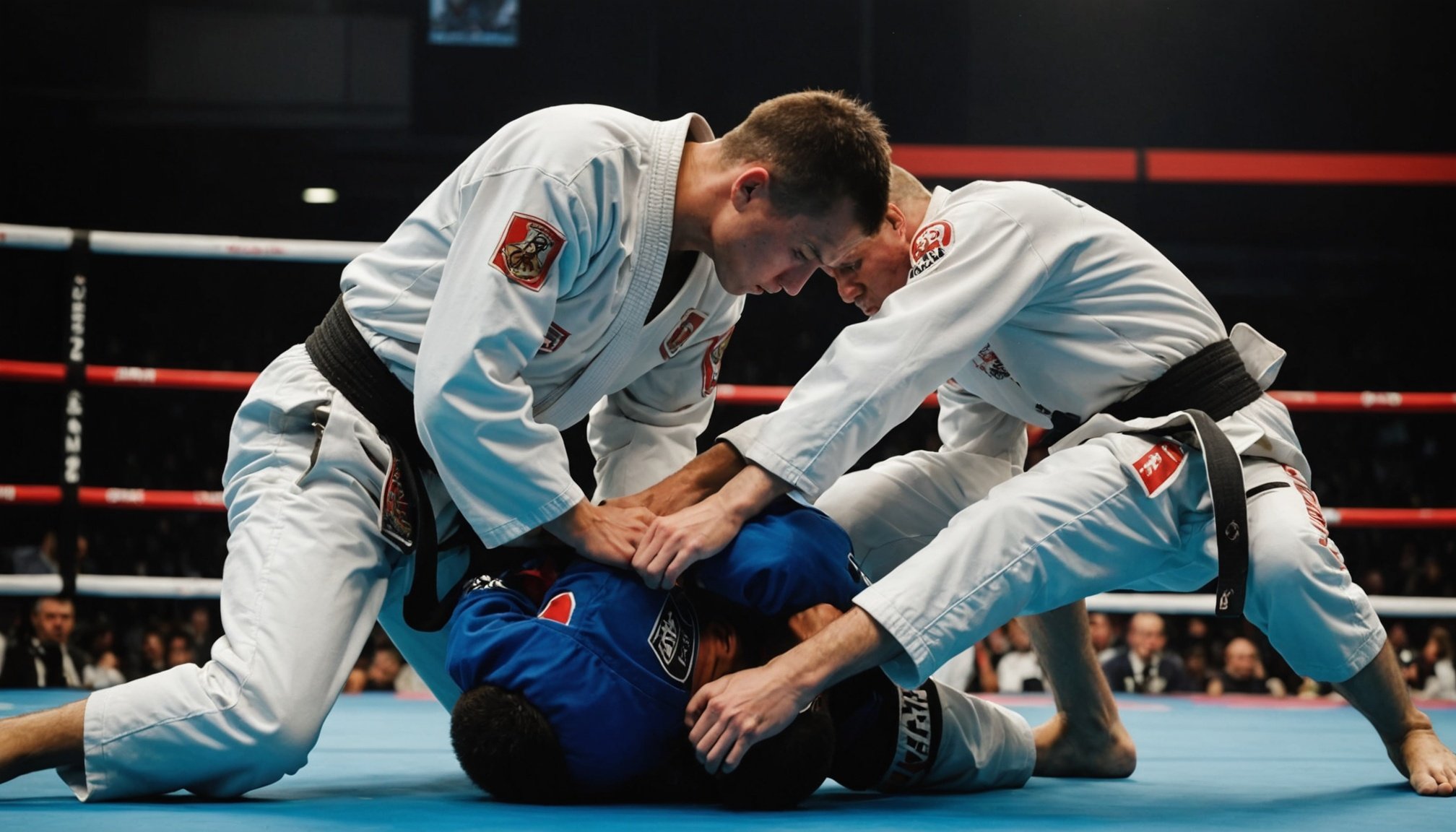Identifying Key Concussion Symptoms in UK Martial Arts Fighters: A Comprehensive Guide
Understanding Concussions in Martial Arts
Martial arts, including disciplines like boxing, mixed martial arts (MMA), and Muay Thai, are highly physical and demanding sports that inherently carry a significant risk of injury. One of the most critical and potentially devastating injuries that martial arts fighters can suffer is a concussion, a type of mild traumatic brain injury (TBI). Understanding the symptoms, risks, and management of concussions is crucial for the safety and well-being of these athletes.
What is a Concussion?
A concussion occurs when the head, neck, or body experiences a blow, resulting in an impulsive force transmitted to the brain. This force causes the brain tissue to stretch, compress, and twist inside the skull, leading to temporary chemical changes and potential damage to brain cells.
In parallel : Exploring Brexit”s Ripple Effects on the UK”s Combat Sports Scene: What You Need to Know
Common Concussion Symptoms in Martial Arts Fighters
Recognizing the symptoms of a concussion is vital for immediate and appropriate action. Here are some common symptoms that martial arts fighters and their trainers should be aware of:
Immediate Symptoms
- Loss of Consciousness: Although not always present, loss of consciousness is a clear indicator of a head injury.
- Dizziness and Balance Issues: Fighters may feel dizzy or have trouble maintaining their balance.
- Headaches and Nausea: Headaches and nausea are common immediate symptoms following a concussion.
- Blurred Vision: Vision problems, including blurred vision or sensitivity to light, can occur.
- Confusion and Disorientation: Athletes may appear confused or disoriented, struggling to remember the event or their surroundings.
Delayed Symptoms
- Memory Difficulty: Fighters might experience difficulty remembering events before or after the injury.
- Mood Changes: Irritability, depression, or anxiety can develop in the days following a concussion.
- Sleep Disturbances: Changes in sleep patterns, such as insomnia or excessive sleepiness, are common.
- Concentration Problems: Athletes may find it hard to focus or concentrate on tasks.
- Physical Symptoms: Fatigue, sensitivity to noise, and emotional changes are also possible.
Risk Factors and Prevention in Martial Arts
Martial arts, by their nature, involve a high level of physical contact and risk of injury. Here are some key risk factors and preventive measures:
Additional reading : Top Strategies for Safeguarding Against Skin Infections in UK Martial Arts Gyms
High-Risk Activities
- Sparring and Live Drills: These activities involve direct contact and are high-risk for head injuries.
- Bag Work and Pad Drills: While less direct, these can still lead to overuse injuries and accidental head trauma.
Preventive Measures
- Proper Protective Gear: Using high-quality headgear, mouthguards, and other protective equipment can reduce the risk of head injuries.
- Technique and Form: Ensuring proper technique and form during training can minimize the impact of blows.
- Regular Breaks: Taking regular breaks during training to allow the body to recover can help prevent overuse injuries.
- Hydration and Nutrition: Maintaining proper hydration and nutrition is essential for overall health and recovery.
Diagnosing and Managing Concussions
Diagnosing a concussion requires a thorough medical evaluation. Here’s how it is typically done and managed:
Medical Evaluation
- On-Site Assessment: Trainers and medical staff should conduct an immediate assessment if a fighter shows any signs of a concussion.
- Medical Examination: A thorough medical examination by a qualified healthcare provider is essential to confirm the diagnosis and assess the severity of the injury.
Post-Concussion Protocol
- Rest and Recovery: The most critical step in treating a concussion is rest. This includes avoiding physical and cognitive activities that may exacerbate the injury.
- Gradual Return to Activity: A gradual return to training and competition is recommended, following a structured protocol to ensure the athlete is fully recovered.
Table: Comparing Common Injuries in Martial Arts and Combat Sports
| Type of Injury | Frequency/Severity | Common in Martial Arts/Combat Sports |
|---|---|---|
| Head or Facial Injuries | High | Boxing, MMA, Muay Thai |
| Knuckle, Hand, or Wrist Injuries | High | Boxing |
| Knee Ligament Injuries | High | Various martial arts and combat sports |
| Broken Bones | High | Various martial arts and combat sports |
| Rotator Cuff Tendonitis | Moderate | Boxing |
| Foot and Ankle Sprains | Moderate | Boxing |
| Nerve Damage | Moderate | Boxing |
| Eye Injuries | Moderate | Boxing |
Practical Insights and Actionable Advice
For martial arts fighters, trainers, and medical professionals, here are some practical insights and actionable advice:
For Fighters
- Report Symptoms: If you experience any symptoms of a concussion, report them immediately to your trainer or medical staff.
- Follow Medical Advice: Adhere strictly to the post-concussion protocol provided by your healthcare provider.
- Stay Hydrated and Eat Well: Proper nutrition and hydration are crucial for recovery and overall health.
For Trainers
- Monitor Training: Keep a close eye on fighters during training and sparring sessions to identify any signs of a concussion.
- Educate Fighters: Ensure that all fighters understand the risks and symptoms of concussions.
- Collaborate with Medical Staff: Work closely with medical professionals to ensure that any suspected concussions are properly evaluated and managed.
For Medical Professionals
- Stay Updated: Keep current with the latest guidelines and research on concussion diagnosis and management.
- Comprehensive Evaluation: Conduct thorough evaluations to diagnose concussions accurately.
- Patient Education: Educate patients on the importance of rest, gradual return to activity, and long-term care following a concussion.
Real-Life Examples and Anecdotes
The Story of a Professional Boxer
Consider the story of a professional boxer who suffered a concussion during a sparring session. Initially, he felt fine but began experiencing headaches and dizziness a few hours later. His trainer recognized the symptoms and immediately stopped his training. The boxer was evaluated by a medical professional and advised to rest for several weeks before gradually returning to training. This early intervention prevented further injury and ensured a safe recovery.
The Importance of Proper Gear
In another instance, a Muay Thai fighter wore substandard headgear during a match and suffered a severe head injury. This highlights the importance of using high-quality protective gear to minimize the risk of head injuries.
Concussions are a serious and common injury in martial arts and combat sports. Understanding the symptoms, risk factors, and proper management protocols is essential for the safety and well-being of athletes. By being aware of these aspects, fighters, trainers, and medical professionals can work together to prevent, diagnose, and manage concussions effectively.
Final Thoughts
As Conor Gormally, Co-founder and CEO of Concussion Alliance, emphasizes, “Concussions are a global public health epidemic affecting tens of millions. It is our mission to create resources to help everyone impacted by concussions learn how to manage recovery and advocate for proper care.”
By taking proactive steps and staying informed, we can reduce the risk and impact of concussions in martial arts, ensuring that these athletes can continue to enjoy their sport while protecting their brain health.











